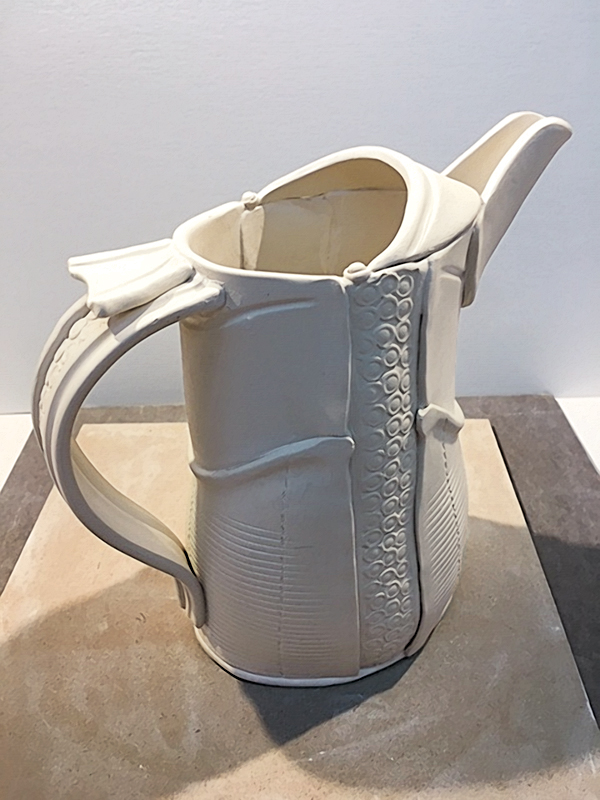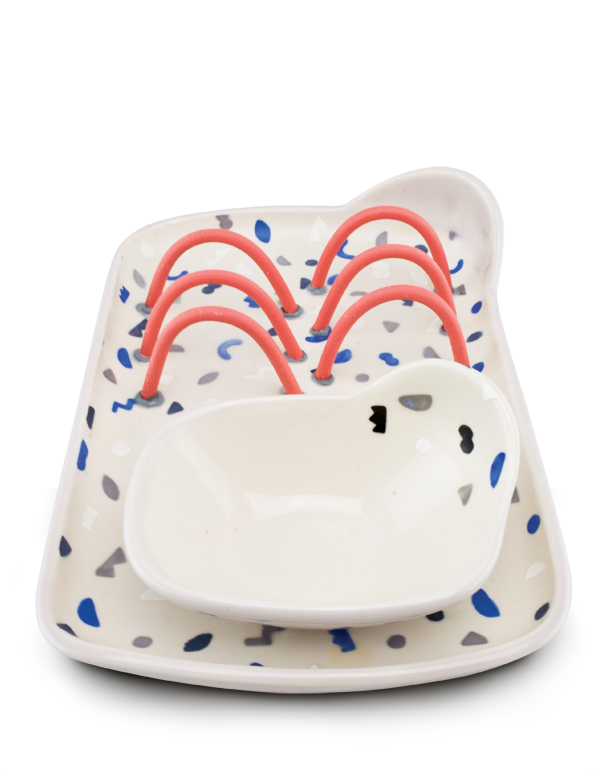-
 Pitcher PerfectDesigning and making pitchers is both exciting and challenging. There are considerations such as leverage, balance, and the movement of liquids as well as aesthetic concerns. Making a pitcher perfect
Pitcher PerfectDesigning and making pitchers is both exciting and challenging. There are considerations such as leverage, balance, and the movement of liquids as well as aesthetic concerns. Making a pitcher perfect -
 Anything is PossibleIn my pottery, I try to create an opportunity for reverie or a feeling of emergent possibility. I have vivid childhood memories of reading stories filled with magical gardens and underground forests m
Anything is PossibleIn my pottery, I try to create an opportunity for reverie or a feeling of emergent possibility. I have vivid childhood memories of reading stories filled with magical gardens and underground forests m -
 Comforting and EnrichingBread and pots, comforting and enriching, come together to make an exciting baking experience using a bread cloche! A cloche is a covered container that traps steam from the dough while baking, result
Comforting and EnrichingBread and pots, comforting and enriching, come together to make an exciting baking experience using a bread cloche! A cloche is a covered container that traps steam from the dough while baking, result -
 Pentalobe Plate and Mollusk SetThe inspiration for the pentalobe plate and mollusk set came primarily from my direct experiences with the natural environment. As a child, I spent countless hours at the beach or in the bays at low t
Pentalobe Plate and Mollusk SetThe inspiration for the pentalobe plate and mollusk set came primarily from my direct experiences with the natural environment. As a child, I spent countless hours at the beach or in the bays at low t -
 Soft Story TellingFunctional ceramics provide a unique opportunity for collectors to interact with fine art on an intimate level. These pieces are often designed to be held in the hands or placed against the lips. They
Soft Story TellingFunctional ceramics provide a unique opportunity for collectors to interact with fine art on an intimate level. These pieces are often designed to be held in the hands or placed against the lips. They -
 In the Studio: Glazing Large WorkGlazing large work requires some special techniques. For work that’s larger than any bucket you may have, there are still several ways to get an even coat of glaze. These techniques can require more t
In the Studio: Glazing Large WorkGlazing large work requires some special techniques. For work that’s larger than any bucket you may have, there are still several ways to get an even coat of glaze. These techniques can require more t -
 In the Studio: Empirical LearningThe sound of an entire stack of pots falling over in a wood kiln at peak temperature isn’t as bad as you’d think. There’s no loud crash. Instead it’s a low, hollow sound dulled by the sticky, pyroplas
In the Studio: Empirical LearningThe sound of an entire stack of pots falling over in a wood kiln at peak temperature isn’t as bad as you’d think. There’s no loud crash. Instead it’s a low, hollow sound dulled by the sticky, pyroplas -
 Editor's Note: Mingei-SotaWhen I first walked into the clay classroom at the University of Minnesota-Twin Cities, I was simply clay curious.
Editor's Note: Mingei-SotaWhen I first walked into the clay classroom at the University of Minnesota-Twin Cities, I was simply clay curious. -
 In the Studio: Business Loans 101Applying for and getting approved for a business loan can be challenging. The more you’re prepared and the lower your overhead is, the better. Your largest expense is mostly likely the location of you
In the Studio: Business Loans 101Applying for and getting approved for a business loan can be challenging. The more you’re prepared and the lower your overhead is, the better. Your largest expense is mostly likely the location of you -
 In the Potter's Kitchen: Milk + CookiesAn invitation to participate in the exhibition “Decadence of Display: Ceramics for Dessert” at Hood College in Frederick, Maryland, in January 2017 provided a sweet distraction from my production work
In the Potter's Kitchen: Milk + CookiesAn invitation to participate in the exhibition “Decadence of Display: Ceramics for Dessert” at Hood College in Frederick, Maryland, in January 2017 provided a sweet distraction from my production work -
 Pottery Illustrated: Altering Oval FormsDrawings adapted from Robin Hopper’s book Functional Pottery, published by The American Ceramic Society and available on the Ceramic Arts Network Shop.
Pottery Illustrated: Altering Oval FormsDrawings adapted from Robin Hopper’s book Functional Pottery, published by The American Ceramic Society and available on the Ceramic Arts Network Shop. -
 Evident Process: Coiling and ThrowingEnvision a cabin or a woven basket: both are constructed in a linear manner and demonstrate a labor of love. In the cabin, one log is stacked carefully atop the others, while in the basket, one pass o
Evident Process: Coiling and ThrowingEnvision a cabin or a woven basket: both are constructed in a linear manner and demonstrate a labor of love. In the cabin, one log is stacked carefully atop the others, while in the basket, one pass o -
 Evolving From Canvas to ClayI began painting as a child, learning oil painting before I was 10. Although I took a lot of ceramics courses in college, I majored in painting and printmaking. A few years after graduating, I found m
Evolving From Canvas to ClayI began painting as a child, learning oil painting before I was 10. Although I took a lot of ceramics courses in college, I majored in painting and printmaking. A few years after graduating, I found m -
 Get a Handle On ItWhen I switched to handbuilding from wheel throwing, I had to rethink how to make handles that best reflected the feel of my handbuilt work, so I began exploring. A few times a year, I set aside a pla
Get a Handle On ItWhen I switched to handbuilding from wheel throwing, I had to rethink how to make handles that best reflected the feel of my handbuilt work, so I began exploring. A few times a year, I set aside a pla -
 Faceted Forms, Geometric GlazingIn all of my ceramic work, including glazed stoneware bowls with faceted planes and cut feet, I seek to integrate form with surface design and glaze color. The form of a bowl and the cut foot guide an
Faceted Forms, Geometric GlazingIn all of my ceramic work, including glazed stoneware bowls with faceted planes and cut feet, I seek to integrate form with surface design and glaze color. The form of a bowl and the cut foot guide an -
 A Good PourEveryday tasks are more enjoyable when using tools that are not only aesthetically pleasing, but also excellently perform the tasks for which they were designed. This versatile bottle was designed for
A Good PourEveryday tasks are more enjoyable when using tools that are not only aesthetically pleasing, but also excellently perform the tasks for which they were designed. This versatile bottle was designed for -
 Constructing and Carving Double-Walled FormsI’ve always appreciated ornamentation and its ability to elevate the ordinary into something magnificent. I’m driven to create work that’s beautiful in its precision and attention to detail and I appr
Constructing and Carving Double-Walled FormsI’ve always appreciated ornamentation and its ability to elevate the ordinary into something magnificent. I’m driven to create work that’s beautiful in its precision and attention to detail and I appr -
 In the Studio: Developing Color: Yellow GlazesThe coloring oxides are the transition metal oxides vanadium, chromium, manganese, iron, cobalt, nickel and copper. Transition metals can combine with different numbers of oxygen atoms to give differe
In the Studio: Developing Color: Yellow GlazesThe coloring oxides are the transition metal oxides vanadium, chromium, manganese, iron, cobalt, nickel and copper. Transition metals can combine with different numbers of oxygen atoms to give differe -
 In the Studio: Group Studio Glaze ManagementA community/group studio, by its nature, has a significant number of variables—not least of which is the glaze palette. Different students will want different colors and properties for their glazes. T
In the Studio: Group Studio Glaze ManagementA community/group studio, by its nature, has a significant number of variables—not least of which is the glaze palette. Different students will want different colors and properties for their glazes. T -
 Editor's Note: Über FunctionThe first stage of pottery making is the one you learn by trial and error through countless hours spent practicing forms after class and by watching endless online throwing videos.
Editor's Note: Über FunctionThe first stage of pottery making is the one you learn by trial and error through countless hours spent practicing forms after class and by watching endless online throwing videos.
- «
- 21
- 22
- 23
- 24
- 25
- 26
- 27 (current)
- 28
- 29
- 30
- »
